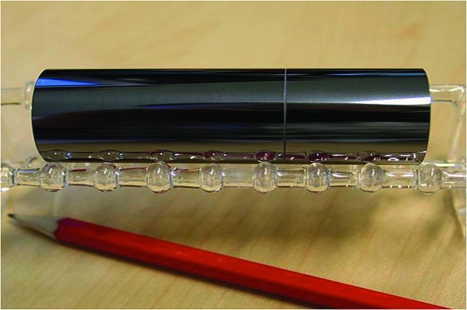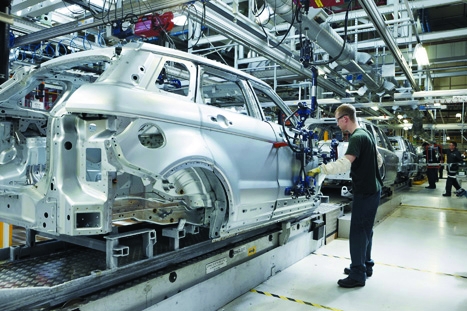Silicon carbide has long been used as an abrasive thanks to its extreme hardness and has more recently found applications in body armour and in brake discs for luxury cars made by the likes of Porsche and Ferrari. But a new method of bonding this fairly inert material, originally developed for building equipment for cutting-edge physics experiments in space, could enable its use in new areas that require precision manufacturing - and the researchers who have created it are making it available free of charge to commercial organisations.

A team from Glasgow University, led by professor of experimental physics Dr Sheila Rowan, has developed the new method of hydroxide catalysis or ’silicate’ bonding based on work originally carried out by Dr Jason Gwo of Stanford University in California.
’Silicon carbide is very hard and very tough,’ said Dr Christian Killow, a Scottish Universities Physics Alliance (SUPA) fellow from Glasgow University’s Institute of Gravitational Research, who worked on the project. ’It’s quite brittle but it’s very good at absorbing impact. The problem with silicon carbide is that it’s fairly inert. It just kind of sits there and does nothing, so when you want to stick something to it it’s not very easy to do.’
The technique originated as a way of joining silica (glass) components to form part of the equipment for detecting gravitational waves – the theoretical way that energy is transported in the form of gravity.
The existence of these waves has yet to be confirmed by experiments – and so the search for them requires very precisely manufactured equipment made from as pure a material as possible in order to reduce potential interference in the instruments, in this case a measurement device known as a Michelson interferometer.
“When bonds go well, they very nearly inherit the bulk strength of the materials that they’re bonding”
DR CHRISTIAN KILLOW, SUPA
So the bonding of the silica components needed to be carried out with as small an amount of adhesive material as possible. In addition, the detection experiments are conducted with high-energy lasers that can destroy epoxy adhesives and inside in a vacuum chamber (or in space), which can cause the adhesives to release gases.
The solution was to encourage the silica components to bond with one another by altering their molecular structure, rather than simply sticking an adhesive material in between them. ’The bond properties in terms of mechanical loss are not great, but what you do get is that they’re very thin – sub-100nm in thickness,’ said Killow. ’There are a lot of things that can go wrong, but when the bonds go well they very nearly inherit the bulk strength of the materials that they’re bonding.’
To create the bond, the surfaces are first made very clean and flat and are then put together with a small amount of bonding fluid such as sodium silicate in between.
This solution etches into the silica, changing its pH and eventually causing polymerisation, where chains of molecules form between the two surfaces to create a solid join.
The Glasgow University team wanted to explore ways to use hydroxide catalysis bonding with silicon carbide, seeing its potential for space applications and other situations where strong, lightweight structures are needed.
The bond is based on chains of hydroxide molecules, which occur naturally on the outside of some materials but not on silicon carbide.

To get around this, the scientists formed a layer of silica on the silicon carbide surface to provide a bonding surface and then applied a bonding solution including hydroxide ions to it. This provides the necessary molecules for the bond to form.
The researchers have decided to make the technology available free of charge to commercial organisations through the Easy Access IP programme at Glasgow University.
This scheme encourages knowledge-transfer opportunities between universities and industry by offering free access to patents and technology.
The method can be used to bond silicon carbide to itself or to components made of other materials, including sapphire, aluminium, silicon and zinc and therefore could have a range of applications.
However, its high stability and thinness make it particularly suitable for manufacturing high-precision equipment.
According to Killow, the bonding process could be tailored to meet the needs of specific applications. ’The logistics of bonding things is a strange process,’ he said. ’It will either fail spectacularly or really work quite well. So when you get it to work, it’s very strong and has a lot of good properties, such as being very thin. But we’re still developing the process and refining it.
’It’s not finished by any stretch of the imagination,’ added Killow. ’We’re trying to develop the process and characterise it because different applications want different properties.’
In depth
quick fix
Rivet studs from Harrison Silverdale have prevented delays to the production of the Range Rover Evoque
Fastener manufacturers working in the automotive industry are used to dealing with companies below the OEMs in the supply chain, providing fasteners for larger components that go on to be incorporated into the final product. But when Jaguar Land Rover encountered an issue while manufacturing the prototype models of its Range Rover Evoque, it turned directly to Derbyshire-based Harrison Silverdale.

’They would receive a body shell from further down the production line that would have so many weld studs on it ready to accept other components to be fitted to it,’ said Mark Harrison, Harrison Silverdale’s sales director.
Jaguar Land Rover found that a small number of studs on the prototype models had been damaged, meaning the component parts couldn’t be fastened to them. ’They then had to remove the weld studs and needed another part that could be riveted to the body without the need for welding equipment at that point in the production line,’ said Harrison. A weld stud is a male-threaded fastener similar to a bolt but featuring a round head with three electricity-conducting pips instead of a hexagonal head. To fix the studs, an electrical current is passed through them, melting the pips and welding the studs in place. ’But you need a special machine to do that and they didn’t have that facility further down the production line when they got to the point of finding that they’d got damaged studs,’ said Harrison.

The automotive manufacturer was nearing the end of the prototype stage so needed to move fast to replace the studs. Harrison Silverdale supplied some rivet studs and portable air tools to fix them in place, preventing delays to the process.
Although it wasn’t a common scenario for Harrison Silverdale, the solution was quickly decided upon, with the company selecting a relatively unusual fastener to meet the needs of Jaguar Land Rover. ’It’s a male-threaded rivet-type stud, and usually these parts are female threaded, and also it had a larger body size than what is more common,’ added Harrison.
’The rivet feature is more of a crimping feature so there’s no welding involved,’ he said. ’Basically the stud has a body on it that passes through a hole in the sheet metal. The tool then deforms the body so it crimps on the back, pulls the body up on the back of the sheet metal and grips it in place.’
Design essentials
The key facts to take away from this article
- A new ’silicate’ bonding technique could enable precision applications
- The method alters the molecular structure of the silica components
- To create the bond, the surfaces are put together with fluid in between
- The bonding process could be tailored to meet specific requirements




Glasgow trial explores AR cues for autonomous road safety
They've ploughed into a few vulnerable road users in the past. Making that less likely will make it spectacularly easy to stop the traffic for...